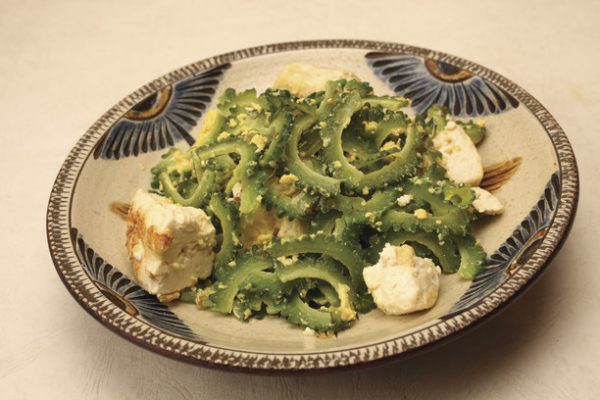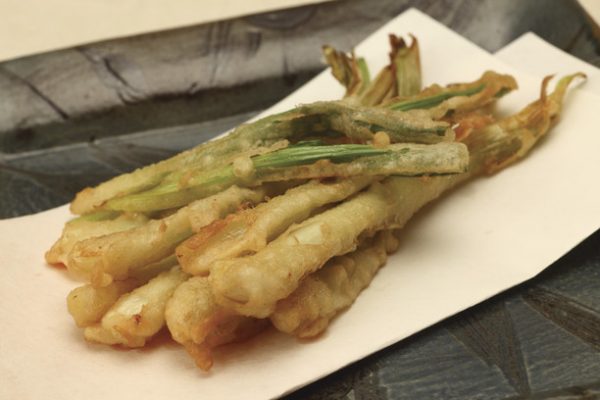The secret to Okinawan’s longevity is often said to be its low-fat, vegetable-based diet. Drawing nutrients from a soil rich in calcium and other minerals, the local produce is brimming with health benefits. Here is a selection of the most common vegetables that have kept islanders healthy for centuries, and a few tips on how to enjoy them.
Goya: Bitter Melon
"Also bitter gourd or bitter squash. A staple of Okinawan cuisine, this vegetable is very little known in Western countries. It is often sauteed to preserve its vitamin C content. The flavonoids responsible for its bitterness are said to stimulate the appetite, which makes it especially popular during the summer.
Season: from April to July
How to eat: in stir-fries or tempura
Nabera: Luffa squash
Another summer vegetable. Though it can be used to make bath or kitchen scrubbing sponges when allowed to fully mature, this fruit is also valued for its subtle sweetness, and thick and slightly texture. To be edible, this fruit of a tropical vine of the cucumber family must be harvested at a young stage of development, about two weeks after blossoming.
Season: from April to October
How to eat: in a miso stew, stir-fries
Papaya
Though papaya is mostly consumed as a fruit, in Okinawa, it is also harvested before maturation and used in dishes as a vegetable. It is often recommended to breast-feeding mothers as a way to boost their milk production.
Season: July to September
How to eat: in salads or cold dishes
Handama greens
Sometimes called Okinawan spinach.
The variety found in Okinawa has leaves that are green on the top and purple underneath.
It is rich in iron and caroten, and has been traditionally valued in Okinawa for its medicinal and anti-aging properties.
Season: from November to May
How to eat: in salads and cold vegetable sides
Shima rakkyō: Island scallions
Smaller in size than its Japanese counterpart, Okinawan scallions have a characteristic, pungent flavour not unlike that of raw onion. Their crisp texture and unique tanginess is addictive: they are the perfect beer (or awamori) snack.
Season: March to May
How to eat: pickled or in tempura
Taimo Yam
Also called "Water yam", it is cultivated in paddy fields. It is especially appreciated for its texture and pleasant sweetness. As a symbol of fertility, it is a key ingredient of the meals served at New Year's or Obon festival celebrations.
Season: December to April
How to eat: Deep-fried or simmered
Shima ninjin: Island carrot
Long and thin, this winter crop looks a little bit like burdock (another Japanese root vegetable), except for its yellow colour.
It is sometimes served to sick people in chimushinji, a soup with offals and red meat.
Season: October to March
How to eat: stir-fried or in a soup
Mōi: red squash
Big and watery, its high potassium contents is especially useful to help you go through the hottest days of summer. Its can be cooked in many different ways and included into a great many dishes thanks to its simple and subdued flavour.
Season: April to September
How to eat: pickeld, or in cold side dishes
※Caution
You may not travel abroad with raw vegetables and seeds in your luggage. Sweet potatoes (including leaves and stems) and water spinach may not be brought to other Japanese prefectures unless in processed food.
▶ Buying veggies in Naha
Nōren Plaza
The 60-year old Nōren Market was renovated in 2017. Here you can find a great deal of fresh produce, meat, fish, and deli.
Address:
Naha, Hikawa 2-3-1 (a 10-minute walk from Kokusai Street)
【The classic: Goya (bitter melon) stir-fry 】

| [ Ingredients ]
・1 bitter melon ・1 pack of hard tofu ・2 eggs ・vegetal oil ・salt ・soy sauce ・pepper
|
[ 作り方 ]
①Drain the tofu and wipe it dry. ②Cut your tofu into cubes ③Throw in the bitter melon slices. When soft, add salt and pepper to your liking. ④Beat the eggs and pour them over the tofu and bitter melon. Add a tablespoon of soy sauce and fry while stirring until the eggs are cooked. |
【Island Scallion tenpura 】

| [ 材料 ]
・A bunch of Island scallions ・Wheat flour 100g ・1 egg ・1/2 of ice cold water ・Frying oil |
[ 作り方 ]
①Peel the scallions, wash and dry. ②Mix the flour, egg, and cold water. Put the scallions into the batter. ③Deep-fry at 180°C (356 °F), until brown. Add salt before serving. |
Did you see anything you like?
We hope we gave you ideas of things to try while in Okinawa!

